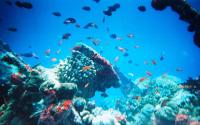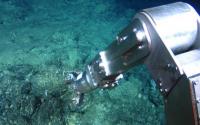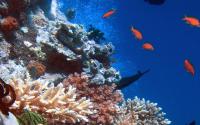Biodiversity

Biodiversity is the degree of variation of life. This can refer to genetic variation, ecosystem variation, or species variation (number of species) within an area, biome, or planet. Marine biodiversity tends to be highest along coasts in the Western Pacific, where sea surface temperature is highest and in the mid-latitudinal band in all oceans.
Quicktabs: Keywords

Almost two-thirds of the hundreds of mollusc species that live in the deep sea are at risk of extinction, according to a new study that rings another alarm bell over the impact on biodiversity of mining the seabed.
[ More ]
The scientists who discovered antibiotic properties in a deep-sea sponge warn that such breakthroughs could be lost in the face of mineral exploitation.
[ More ]
The nations of the world have launched a historic two-year process to create the first-ever international treaty to protect life in the high seas.
[ More ]
A U.N. working group is discussing a proposed "international mechanism" for the protection of oceans. Any such treaty or convention will be a new implementing agreement under the 1994 U.N. Convention on the Law of the Sea (UNCLOS).
[ More ]South countries, such as the 53 nations in the Africa Union, are advancing the way forward by legislating national laws for protecting, while at the same time sharing, biodiversity as advocated by the CDB. Such an approach delimits individual private property by affirming community rights over biodiversity, in shared jurisdiction with national governments. Another initiative among non-governmental organizations revives the international discussion that the gene pool, like the seabed, belongs to the common heritage of mankind:
the intrinsic value of the Earth's gene pool.. .precedes its utility and commercial value .... [T]he Earth's gene pool, in all its biological forms and manifestations, exists in nature and, therefore, must not be claimed as intellectual property even if purified and synthesized in the laboratory .... Therefore, the nations of the world declare the Earth's gene pool... to be a global commons, to be protected and nurtured by all peoples and further declare that genes and the products they code for, in their natural, purified or synthesized form... will not be allowed to be claimed as commercially negotiable genetic information or intellectual property by governments, commercial enterprises, other institutions or individuals.99
Only in the preliminary stages of discussion in international fora, such as the Johannesburg Summit, ten years post-Rio (August 2002), this proposed treaty renews the debates over equity in the use of "common heritage" resources. As this discourse continues, legal interpretation and political experience from UNCLOS will become relevant for clarifying key issues, especially debates over private versus community versus public property over resources necessary to sustain all human life. An international law of the seed will develop dynamically, from shared use and adjudication, as is the international law of the sea.
As a summary, the chart below offers a quick comparison of important provisions of the United Nations Convention on the Law of the Seas (UNCLOS), the Trade Related Intellectual Property Rights (TRIPs) and the Convention on Biological Diversity (CBD). As discussed above, access to the sea and seed ranges from delimitation of private property under UNCLOS to allowing full privatization under TRIPs to reaffirming national control under the CBD. The extent of the enclosure against access is most serious for TRIPs and could potentially be legalized for all seeds and plants. Sustainable use of resources is a priority for UNCLOS and the CBD but is not even mentioned in TRIPs. Similarly, while it has been left undefined, both UNCLOS and the CBD promote benefit sharing, while TRIPs does not mention it. TRIPs is also the most narrow in its approach to rights, mainly recognizing individual rights. UNCLOS is the most ambitious with its principle of the common heritage of mankind giving equal rights to all beyond the exclusive economic zones (EEZs) of 200 nautical miles. The CBD enshrines community and farmers' rights (social group rights) as privileged over individual rights for seeds and plants, which belong to the common heritage of local communities. Finally, UNCLOS employs an international authority as well as legal adjudication for governance. TRIPs relies on national enforcement, with dispute settlements to follow administrative panels' rulings that are arrived at without full disclosure or the ability to cross-examine the opponent. The CBD also relies on national enforcement' with the condition that prior informed consent must come from the communities who cultivated the plant. "National" enforcement, therefore, is modified by the proviso that local communities participate in drafting agreements about seed exchange and benefit sharing, including devising local community trusts.
The International Tribunal for the Law of the Sea, established by UNCLOS, provides the forum for the peaceful settlement of disputes. Its major caseload tends to be arbitration over detention of ships and their crews for fishing unlawfully (e.g., over-fishing) or other violations within the EEZs. The Tribunal decides the terms of release of the crews and ships (e.g., posting of bonds) while a case proceeds. Arbitration is compulsory in most categories of disputes, but some cases are taken to the International Court of Justice (e.g., maritime delimitation). In 2000, the parties to UNCLOS established a trust fund, similar to that used by the ICJ, "to assist states in proceedings before the Tribunal" in order to overcome financial impediments to seeking judicial arbitration of 79 disputes.
The country with the most powerful biotech corporations has not ratified the CBD, as it has not yet ratified UNCLOS. One reason offered by the United States for refusing to sign in 1992 was that bio- prospecting contracts, such as the one between Merck and INBio in Costa Rica, would obviate the need for an international treaty. From this point of view, benefit sharing should be left up to individual contractors (corporate and community), not promoted by government interference (joint ventures). Others, even those involved in bio-prospecting, view an international treaty as a necessary guideline for the prospecting.71
The CBD follows UNCLOS in asking for benefit sharing of the uses of biodiversity. 61 Similarly, developing countries, led by China, India, and Brazil, argued that the CBD allows them access to bio-technology that would enable them to exploit their own biological resources.62 The compromise became a call for the transfer of technology and for "fair and equitable sharing of the benefits" when knowledge and resources are exchanged.63 In addition, the CBD requires prior informed consent (PIC) of the local community for access to a bio-resource, not just the central state, which could sell off vital resources for a pittance.64 All stakeholders must mutually consent.65 Materials collected before the formation of the CBD in 1992 are not covered.
Neither the CBD nor UNCLOS has fully defined benefit sharing, but discussions prioritize sharing knowledge and funds for research and development. Discussions have progressed for the CBD, where the need for exchange is more mutual: the North desires access to the biodiversity of South countries, while the South would like access to technology. Of course, all would like to share profits from any practical uses of the resources. The discussion addresses fees for access to germplasm, royalties, profit sharing (much more than the estimated zero to five percent currently offered),66 technology, and funds for development.67
Eventually, the seabed regime may also be called on to make adjustments thrust upon it by states acting outside the authority. If the authority gains the trust of its members as an effective manager and steward of deep ocean minerals, it is possible that states may negotiate to add other deep ocean issues to the responsibilities assigned to the authority by UNCLOS and the 1994 Agreement. The subject of the management, protection and exploitation of the biodiversity of life on the deep ocean floor has gained some attention.36 While there is only limited knowledge of the scope or the fraglity of the marine life of the seabed, there have been discussions of the potential commercial value of this resource.37 The authority, charged with protecting the marine environment, must consider effects on marine life of mineral exploration and exploitation. It is conceivable that a new agreement could extend the role of the authority to the management, exploitation and protection of deep seabed biodiversity.
In this context, marine species and microorganisms that have evolved to exist in extreme environments, so-called "extremophiles," are of particular interest. Such environments and habitats include the deep sea, as well as in the vicinity of seamounts, hydrothermal vents, methane seeps. Such features have been discovered on the extended continental shelf. Organisms living here have adapted to survive in the complete absence of light, in conditions of extremely high pressure, in either low or very high (for example in the vicinity of a hot water vent) temperatures, or in environments characterised by extreme salinity or acidity.
This has led to the emergence of "bioprospecting" and the deep seabed, including outer continental shelf areas, are likely to be a focus for these activities. This represents a potentially rich resource and opportunity for coastal states. Indeed, marine biotechnology-related products were estimated to be worth $100 billion (USD) in the year 2000 alone.86 The potential for further growth in marine bioprospecting is emphasised by the fact that around 1,000 new marine natural products are reported annually. This points to how biodiversity-rich yet under-explored and thus little known the oceans are. Indeed, it has been suggested that the oceans are ninety-five percent unexplored." Moreover, the number of ocean-dwelling species has been estimated at around ten million-a figure fifty times greater than the number of marine species reported thus far. In this context, deepwater areas hold particular promise as they are likely to host unique extremophiles and also because these areas are least explored, notwithstanding considerable advances in technologies applicable to exploring deep sea areas made in recent decades. This is illustrated by the fact that of over 30,000 marine natural products reported since the 1960s, less than two percent derive from the deep sea organisms.89
